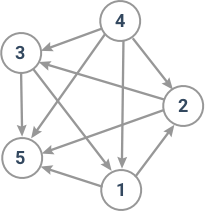Determine if the given directed graph is a tournament. A tournament is a directed graph in which every pair of distinct vertices is connected by a single directed edge.
Example
For
n = 5,
fromV = [2, 1, 3, 4, 4, 4, 1, 2, 3, 4] and
toV = [3, 2, 1, 3, 2, 1, 5, 5, 5, 5],
the output should be
isTournament(n, fromV, toV) = true.
Here's how the given graph looks like:

Input/Output
- [time limit] 4000ms (js)
[input] integer n
A positive integer n representing the number of vertices in the given graph.
Guaranteed constraints:
1 ≤ n ≤ 10.[input] array.integer fromV
An array of integers containing integers less than or equal to n.
Guaranteed constraints:
0 ≤ fromV.length ≤ 50,
1 ≤ fromV[i] ≤ n.[input] array.integer toV
For each i in range [0, fromV.length)there is an edge from the vertex number fromV[i] to the vertex toV[i] in the given directed graph.
Guaranteed constraints:
toV.length = fromV.length,
1 ≤ toV[i] ≤ n.[output] boolean
true if the given graph is a tournament, false otherwise.
Solution
If we list all possible pairs of nodes for \(n=5\) and mark the ones for the given graph it may look like this:
(1, 1), <strong>(1, 2)</strong>, (1, 3), (1, 4), <strong>(1, 5)</strong><br />(2, 1), (2, 2), <strong>(2, 3)</strong>, (2, 4), <strong>(2, 5)</strong><br /><strong>(3, 1)</strong>, (3, 2), (3, 3), (3, 4), <strong>(3, 5)</strong><br /><strong>(4, 1)</strong>, <strong>(4, 2)</strong>, <strong>(4, 3)</strong>, (4, 4), <strong>(4, 5)</strong><br />(5, 1), (5, 2), (5, 3), (5, 4), (5, 5)
We now mirror the connections and see this nice pattern, where only the diagonal remains unmarked:
(1, 1), <strong>(1, 2)</strong>, <strong>(1, 3)</strong>, <strong>(1, 4)</strong>, <strong>(1, 5)</strong><br /><strong>(2, 1)</strong>, (2, 2), <strong>(2, 3)</strong>, <strong>(2, 4)</strong>, <strong>(2, 5)</strong><br /><strong>(3, 1)</strong>, <strong>(3, 2)</strong>, (3, 3), <strong>(3, 4)</strong>, <strong>(3, 5)</strong><br /><strong>(4, 1)</strong>, <strong>(4, 2)</strong>, <strong>(4, 3)</strong>, (4, 4), <strong>(4, 5)</strong><br /><strong>(5, 1)</strong>, <strong>(5, 2)</strong>, <strong>(5, 3)</strong>, <strong>(5, 4)</strong>, (5, 5)
Creating a set of unique connection tuples, is pretty straightforward using python3, by concatenating the two arrays \(f\) and \(t\). Duplicates get kicked out by the set creation: {*zip(f + t, f + t)}. Since the given constraints \(1 \leq f[i] \leq n\) and \(1 \leq t[i] \leq n\) all numbers are valid and we only need to work with the count. How many distinct tuples do we have? n-squared minus the diagonal. This allows us to implement the following routine:
isTournament = lambda n, f, t: len({*zip(f + t, t + f)}) == n * n - n
The routine would be perfectly small, but fails if the number is correct, but a duplicate connection gets removed. That's why we also need to check if the original length is okay to form the actual matrix:
isTournament = lambda n, f, t: len({*zip(f + t, t + f)}) == n * n - n and n * n - n == 2 * len(f)
Merging the two conditions to form a smaller solution yields the following final form:
isTournament = lambda n, f, t: n * n - n == 4 * len(f) + len({*zip(f + t, t + f)})
Using an adjacency matrix \(M\) we built before, we can solve the problem more elegantly by using an environment like Julia or Matlab:
isequal(M + M', 1 - eye(size(M)...))